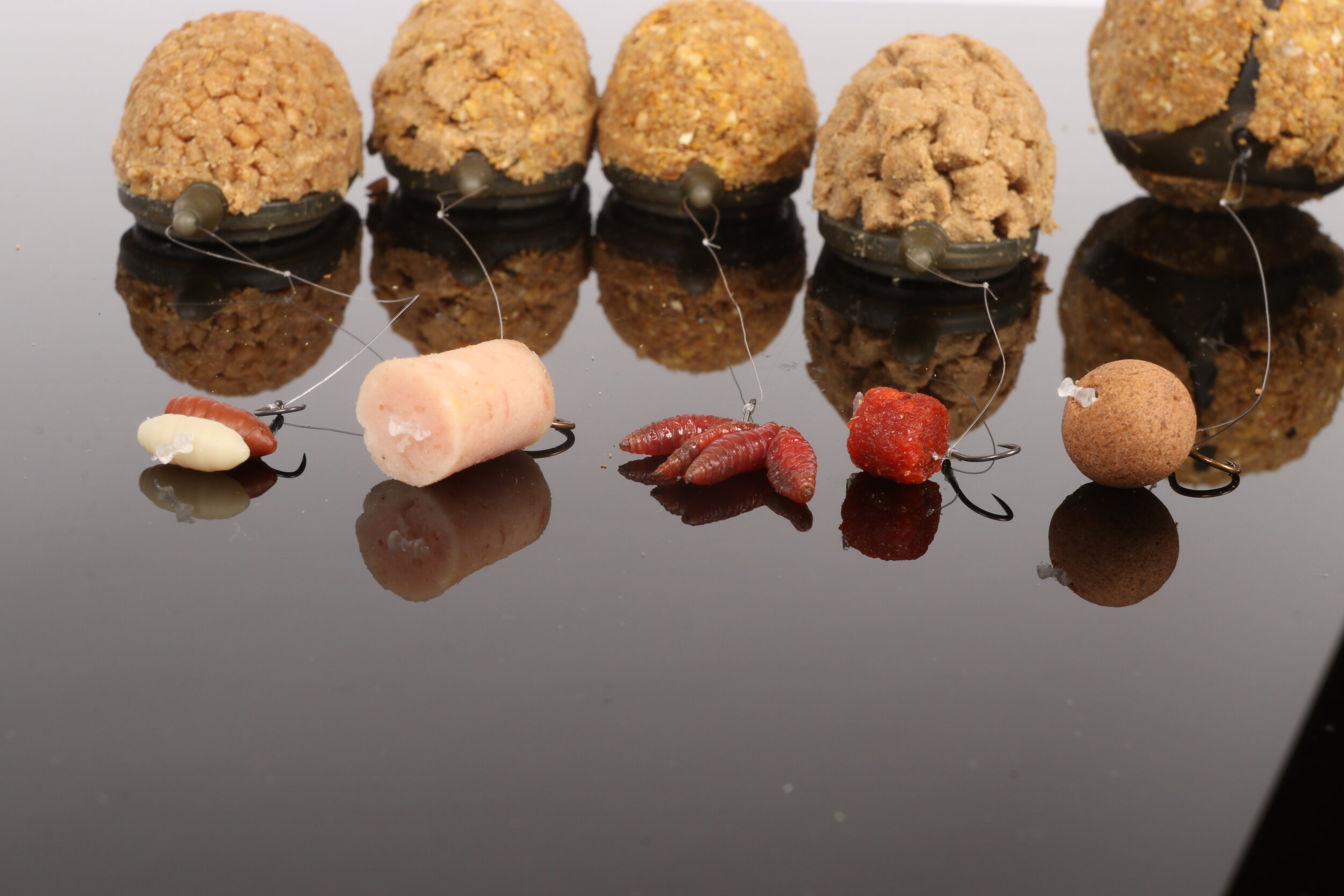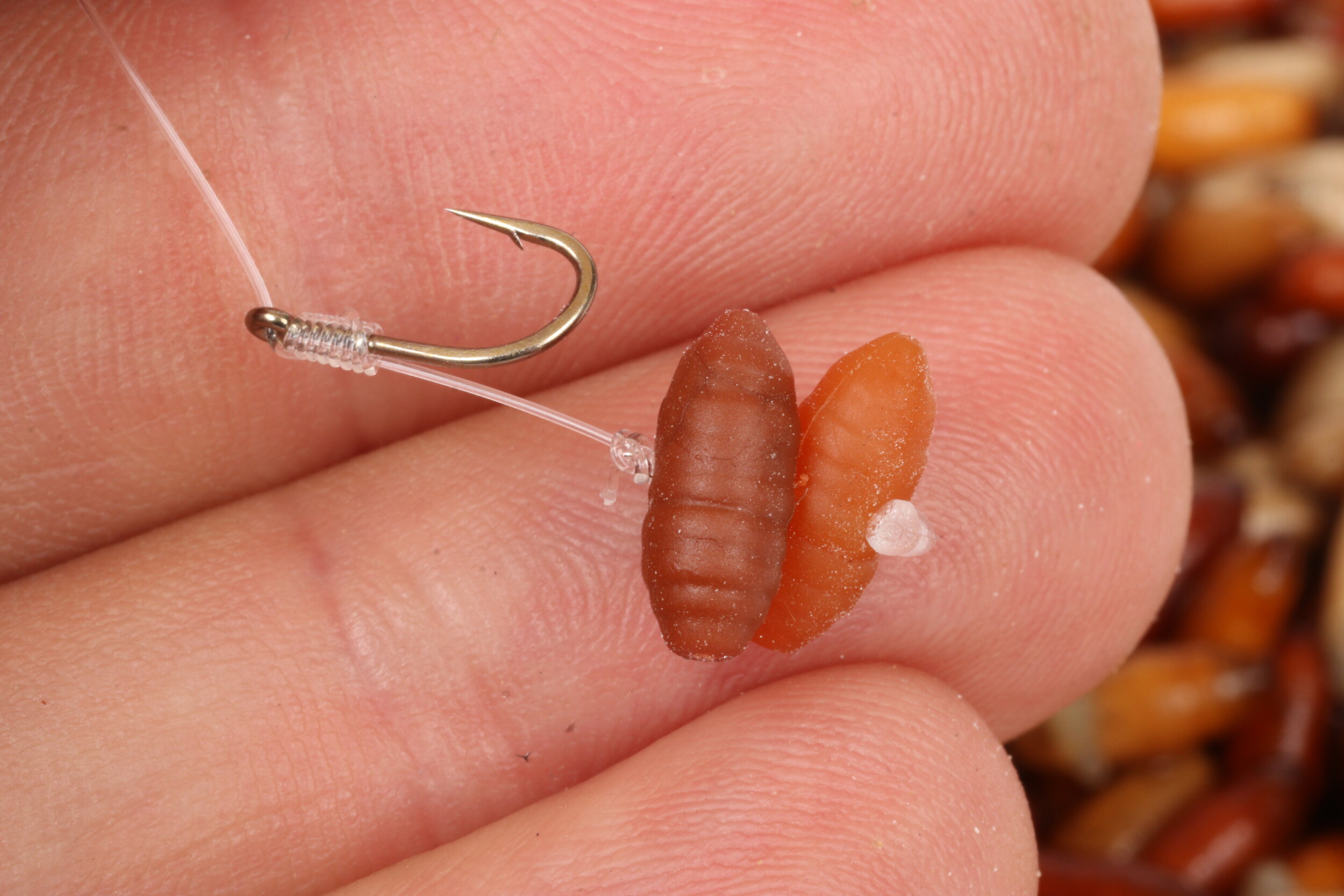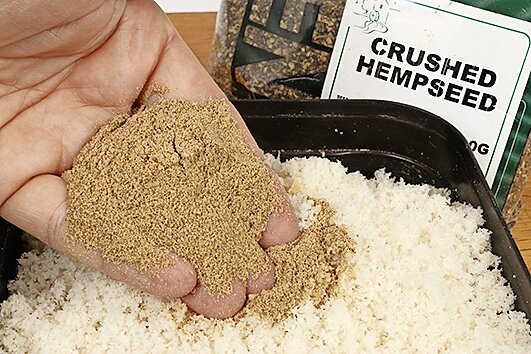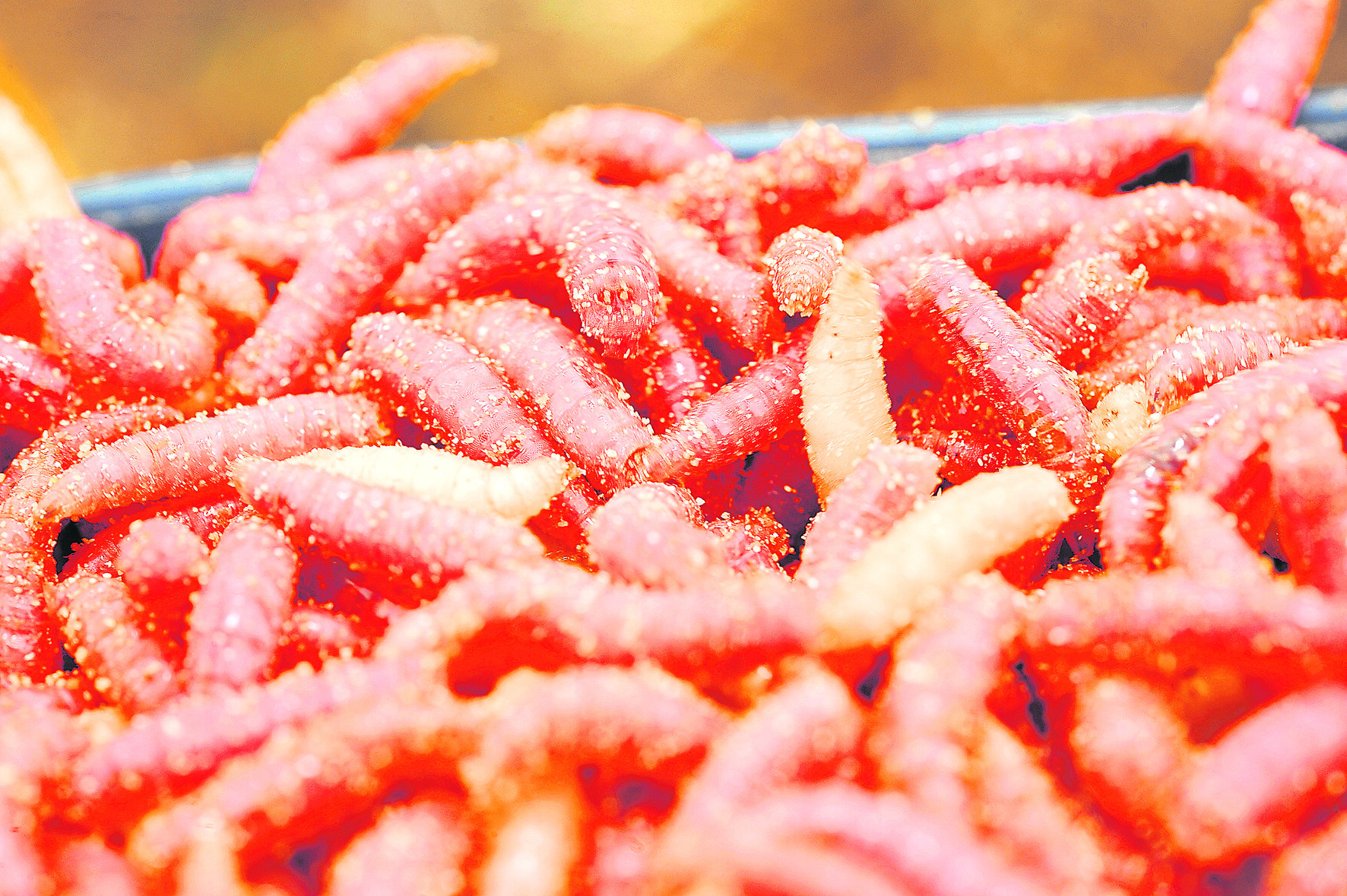Can paste be used on a leger rig? - Paul Garner
Paste can be used on rod and line, but for it to withstand the impact of hitting the water while being towed by a big lead it needs to be sticky.
This is easy to achieve, and there are several purpose-made paste mixes for this job. Follow the mixing instructions carefully with these baits, as the paste needs time to form strands of gluten that bind it together.
You can tell when the paste is ready to use as it will be almost stringy when you pull it apart.
A hair rig will also help you hook more fish when legering paste. Try moulding the bait around a paste cage, as this will keep it attached without impeding the hookpoint.
A paste cage on a hair rig is perfect for legering paste
The best method feeder hookbaits - Paul Garner
Hookbait choice can make a huge difference to your Method feeder catches.
Some score best with bigger fish, while others will win you extra bites on tough days. Here’s my pick of the bunch...
Picking the right hookbait can get extra bites on the method feeder
Fake baits
Artificial casters will pick off bigger fish than the real thing, and are great when there are a lot of nuisance fish around. Most packs contains different colours, so see which one the fish prefer on the day.
Dark baits often score in summer, but the off-white ones can bring bonus fish when the going gets tough.
Best for: Tench, crucians and carp
Artificial casters will pick off bigger fish
Punched meat
Easy to use, and with a distinctive taste that carp love, punched meat is one of my favourite Method hookbaits for larger carp.
Cut the meat into 10mm-thick slices and use a bait punch to produce perfect 6mm hookbaits, stepping up to 10mm when they are feeding well.
Best for: Big carp
One of my favourite baits for larger carp
Dead maggots
A bunch of four dead red maggots is very effective, especially in the cold, when small fish are less active. I like to use maggots that have been frozen.
They have a soft, stretched appearance, but are still quite tough. Use a bunch on a size 12 hook.
Best for: Bream, tench and carp
Dead maggots come into their own when it is cold
Pellets
For Method fishing I like an 8mm tough hooker pellet. The consistency is ideal for hair rigs, and I use them with a Quick Stop to make baiting-up simple.
In summer go for savoury flavours, while in winter, sweeter flavours work better.
Best for: Carp, tench, bream and F1s
Go for savoury pellets in the summer
Wafters
These slightly buoyant hookbait boilies only just sink, and hover just above the bottom. Being semi-buoyant, they are easy for larger fish to suck up, giving more bites and better hookholds too.
Wafters are tough baits, so you can often catch several fish on the same one. Hair-rig them using a boilie spike for best results.
Best for: Carp and bream
You can often catch several fish on the same wafter
"It has to be bread for river roach" with Dr Paul Garner
Roach are staging a substantial comeback. Whether from the tremendous work of the Avon Roach Project, or natural recruitment on other rivers, big roach are out there for those willing to look for them.
Very often the first clues are fish caught by accident, often by chub or barbel anglers, using heavy gear. Be quick to follow up on these leads and you might just strike the silver fish mother lode.
WORLDS APART
Quite why river roach should be willing to feed on a much wider range of baits than their stillwater cousins, especially in the winter, can only be guessed at. I think it is probably because in stillwaters small invertebrates make up virtually all of the fish’s diet. This means that they become fixated on small baits, such as maggots.
In rivers, big roach will have a wider natural diet, and so are not as choosy. Heavily-fished carp lakes are almost a halfway house, with large volumes of boilies, sweetcorn and pellets going in to supplement the roach diet. Yet, even here, the number of big roach caught on these baits can be minuscule, especially in winter.
PUNCH IT
I grew up among an older generation of dyed-in-the-wool roach anglers whose tactics are just as good today as they were back then. Bread was their bait of choice, normally fished under a big balsa float to hold the line when trotting downstream. Today we might prefer to quivertip with a small feeder, but the bait choice remains the same
A decent-sized piece of bread can be a very selective bait, picking out the bigger fish.
A punch of around 8mm is perfect for producing big-roach hookbaits, although you must get the texture right to keep the bread on the hook. Look for a thick-sliced white loaf with a dense structure. Cheaper loaves tend to be full of air pockets that lead to their falling to bits.
To toughen up your slices of bread, compress them overnight. I use an offcut of kitchen worktop heavy enough to halve the thickness of the slices overnight.
Place a damp cloth between the bread and the weight to stop it sticking and to add a little moisture. Store the slices of bread in an airtight bag to stop them drying out.
TRY A CAGE
A small cage feeder is an easy way of feeding bread. A dry mix will hold in the feeder, but break down quickly. Drop your feeder into a bait tub of water to see how long it takes to break down.
CLOUDY FEED
Whether I am floatfishing or feeder fishing, my feed is based on punch crumb. This very fine white crumb is much less sticky than normal white breadcrumb and has an almost gritty texture. Mixed dry it will form an excellent cloud in the water column, but add a tiny bit more water and it will hold together and sink quickly.
Alternatively, remove the crusts from a few slices and put the white flake through a food liquidiser until it has been ground to a fine consistency.
This liquidised bread holds together perfectly in a cage feeder, and can be added to punch crumb when floatfishing to help get it down.
Roach don’t have big appetites, so avoid adding any larger pieces of bread to the feed. Two ingredients that are worth adding are a pinch of crushed hemp and the same of crushed pellets. Using pellets for river roach may seem odd, but roach do like the taste of pellets, even in rivers where they aren’t used a great deal.
MY CAGE FEEDER MIX
A combination of liquidised flake and punch crumb makes the ideal feed for a cage feeder.
Here is how I make mine...
Remove the crusts from six slices of white bread and break them into pieces.
Use a liquidiser to reduce the flake to fine particles. Make sure that you remove as many lumps as possible.
Add a small amount of crushed hemp and pellet powder to two pints of liquidised bread.
Use an atomiser to very lightly wet the mix to help it bind together.
Add a small amount of punch crumb if a stiffer mix is required.
***FOR MORE GREAT BAIT TIPS FROM PAUL, PICK UP THE MAGAZINE OUT EVERY TUESDAY***
Dr Paul Garner's 10-minute make | The chopped worm method
The Method feeder is a great way of catching tench – the combination of groundbait and chopped worm is hard to beat, especially with my secret ingredient, Krill powder.
Into a bait bowl add three parts of Dynamite Baits’ Swim Stim Green groundbait to one part Krill powder. Mix it up dry to start with.
Wet the groundbait slowly until it will stick well to a flat Method feeder. Leave to stand for a while until the water is fully absorbed.
Finely chop a handful of dendrobaena worms so that they are reduced to a fine mush, then mix the worms into the groundbait.
Use a Quick Stop on a size 12 hair rig to hold a worm in place. The stop can be pushed through the worm, but will then hold it securely.
Alternatively, try swapping the worm for an artificial caster on the hair. This will often produce extra bonus tench.
Dr Paul Garner's potato hookbaits
I suppose you could say that potato hookbaits really are as cheap as chips! While not suitable as feed, potato can easily be cut into slices and punched to make a tough hookbait. Better still, it takes on colours and flavourings readily, making it a very low-cost, easy-to-use alternative to other hookbaits.
Cut a potato into 10mm thick slices using a sharp knife. There is no need to remove the skin.
Use a bait punch to produce your plain hookbaits. Punches of 10mm and above work best with this quite tough bait.
Add a teaspoonful of Strawberry flavouring and half a teaspoonful of red dye, and shake well so that the baits are evenly covered.
After a few minutes the potato will have absorbed the colour and flavour. For best results, leave overnight in the fridge.
Potato baits are easy to hair-rig and are long-lasting, making them ideal for use with the Method feeder.
Dr Paul Garner's 10 minute make | Preparing micro pellets
Micro pellets cannot be prepared in the same way as pellets of a larger diameter, simply by soaking or pumping – try to do that and they will quickly turn to a mush.
Instead, you have to add water a little at a time, allowing time for the micros to absorb moisture but never become saturated. You can add liquid flavouring to the mixing water (right) and for an extra ‘kick’ try a teaspoonful of rock salt sprinkled over the prepared pellets.
Add a teaspoonful of Cappuccino flavouring to a pint of lake water and mix well.
Slowly add some of the water to the micro pellets in a shallow mixing bowl. The pellets should soak up the water immediately.
When the pellets start to become tacky, leave them for five minutes so they are able to start absorbing the water.
Carefully add a little more water until the pellets are quite tacky but are still absorbing water.
Sprinkle a teaspoonful of rock salt over the pellets to give them an extra boost.
This is what the finished setup looks like!
Paul Garner's top tips for colouring your bait!
One of the easiest changes you can make to many baits is to alter the colour, but does this really make any difference to catches? I don’t think that fish are attracted to any one colour, but some are definitely more visible than others in different venues, and this can influence our results.
On heavily pressured venues, using a colour that is different from the norm can also catch you more fish, especially if you use some of the more obscure hues.
What can coarse fish see?
Coarse fish have eyes that are not much different from ours. However, they can see some ultraviolet light beyond the blue end of the spectrum that we can see, useful in deep water where most light is at this end of the spectrum. Rather than what colours fish can see, we would be better asking what colours are visible in the murky depths of a river, or the clear water of a lake? Light at the red end of the spectrum is actually absorbed quite quickly. If you go down to 30 feet then even in a gin-clear lake, reds will appear as shades of grey.
Most of the time, though, we aren’t fishing in water anything like this deep, so the colours we see are not that different to what the fish will be seeing too. At night colour becomes less important. Even though fish can see quite clearly on even a moonless night, they will see in black and white, with bright colours appearing as lighter shades of grey and dark colours like red appearing almost black.
Paul's top tips for dyeing your baits
Many baits will take colours easily, and some anglers who have experimented with unusual combinations have enjoyed surprising success until the fish become ‘wised up’ to them.
Why not experiment yourself, with simple food colourings? The sky’s the limit!
1)
As a general rule, you can make light-coloured baits darker, but you can’t make dark baits lighter. So remember this when colouring your baits. chickpeas, for example, will take red dye easily.
2)
Baits that are naturally moist, such as sweetcorn and chickpeas, can be easily coloured using powdered dyes.
3)
Chop meat into chunks or cubes and then lightly spray on some liquid dye. After a few hours the meat will absorb it.
4)
Groundbaits can be dyed using powdered colours added to the dry ingredients before mixing. Use dark in clear water.
5)
Maggots are very difficult to colour at home, so it is best to leave it up to the experts and buy them ready-dyed.














































